Monday Morning Update 4/4/11
From Outside Looking In: “Re: Ann Lazerus. The president of the Siemens MS4 division is retiring. MS4 had 500 clients at its height, but Siemens is trying to woo them to the less proven and less stable Soarian. An executive was quoted as saying Siemens will bid Soarian down to 100 beds. MS4 support has been cut back, MS4 executives aren’t even bothering to contact their assigned clients because they’re competing with their Soarian counterparts. ,Once MS4 clients see the price, 90% of them don’t even bring Soarian back as a finalist. If Siemens wants Soarian opportunities from MS4 and Invision clients, they should keep current promises and not make new ones.” Unverified.
From Palomar: “Re: sponsors. Surely you have run across some that were problems. Need to know!” Only one has ever really ticked me off and that was mTuitive in 2006. They begged to have their small Gold sponsorship fee broken down into quarterly payments, then stiffed me after paying one of the four payments due. They were high maintenance to boot, making excuses about not paying, pestering me to sit through a never-ending demo, and even expressing astonishment after they broke our gentlemen’s agreement that I wasn’t giving them enough exposure on HIStalk. I’m nearly always unbiased, but in this case, I’m always happy to ignore their good news and highlight that of their competitors (like Mark Twain said, never pick a fight with a man who buys his ink by the barrel). Other than mTuitive, every company has been great to work with.
From The PACS Designer: “Re: Chrome 10. If you’re a Chrome user, Information Week has published the screen views of the mostly minor changes that improve Chrome 10’s performance. Philips and Siemens are members of the Healthcare IT Workgroup for Chrome 10, Microsoft IE9, and other browsers, along with Cisco and many other IT vendors.” I have to say I like Firefox 4.0 better than Chrome at the moment, but not by much.
From Sick of Snow: “Re: Bayonne Medical Center (NJ). The CIO has been replaced by a hired gun from Network Infrastructure Technology out of New York.” Unverified. Dimitri Cruz was the CIO and still lists the CIO job on his LinkedIn profile.
From MaxPayneUK: “Re: CSC’s purchase of iSoft. What, exactly, will they get? Perhaps a chance to purge the UK management cupboard, a ready-made client base for Lorenzo, and a chance to jettison some of the acquisitions made — and still pocket some change. Nah, can’t be that easy.”
From Seekhau: “Re: [company name omitted]. I heard they’ve signed the agreement to acquire [company name omitted]. Closing will be in the next two weeks.” I already knew about that one and mentioned it (in redacted fashion) previously (since one of the players is publicly traded). I’ll characterize it as somewhat interesting, particularly with regards to the previously signaled strategy of the acquirer.
Two-thirds of respondents said Epic wouldn’t be a good choice for DoD when I ran that poll a few months ago. This time around, 58% said VA/DoD should choose a commercial system instead of building their own open source system. New poll to your right, sure to stir up some civic competition: which city has the strongest claim to call itself the capital of healthcare IT?
Listening: The Kooks, cheery British pop. The heavy Brighton accents (like dialed-back Cockney) annoyed me a little until I realized I should commend them for not adopting fake American ones just for singing, the kind that disappear when talking (Jagger, Robert Plant, and just about everybody else from there trying to cash in with US hits). It balances out, though, as frothy US celebrities like the Michigan-raised Madonna trot out pretentious, comically phony generic Brit accents (at least she lived in London for a while).
Welcome to new HIStalk Gold Sponsor Winthrop Resources of Minnetonka, MN. The company helps organizations make technology financing decisions (operating leases, sale-leaseback, etc.) allowing them to remain independent of technology providers, to refresh technology when needed, and to preserve cash. Winthrop believes that spending cash or expensive bank financing to buy technology assets doesn’t make sense since those assets lose value quickly, require increasing expense to keep running, and need to be upgraded and changed to support organizational goals. The company just earned its HFMA Peer Review Designation and makes its healthcare experts available to help understand the forces in the healthcare and technology markets that affect healthcare strategies. Thanks to Winthrop Resources for supporting HIStalk.
I’ve always wondered why readers send me “hey, did you see this?” news items that I’ve already mentioned prominently. Now I know: they’re speed-reading and missing stuff. I thought I had put in plenty of obvious clues and humor in my “I’m quitting” April Fool’s post to accentuate the joke, but some folks skimmed right over that and e-mailed me to express their sorrow that I’m hanging up my keyboard (or e-mailed Inga to tell her she could do better than to run away with me and my made-up millions — gee, thanks). My summation: (a) I’m not leaving – despite brutal hours and occasional annoyances, I’m having the time of my life; and (b) while Inga is indeed quite the package, when it comes to Mrs. H, to quote the old commercial, I think I’ll keep her. I’m disappointed that nobody seemed to notice that the name of the band Inga and I are starting is an an anagram for “April Fools” (the former chocolate magazine reporter turned healthcare IT expert is true, however). I’ll think positively in assuming that the well-wishing readers were just going along with the gag. Fight the urge to skim HIStalk – it’s not like a newspaper that makes more important articles huge, so you’re guaranteed to miss something important if you just scan down the screen.
Next up in my “time capsule” series of editorials you’ve never seen since they ran in a newsletter you didn’t get: my January 2006 take on the then-new CCHIT. I couldn’t wait to make fun of their name, which I now note happened in the first sentence.
The VA issues an RFP to launch the project to develop an open source replacement for VistA. It seeks a Custodial Agent to create and oversee a structure that will certify the open source code base, certify proprietary software that can work with it (that could be huge), and allow individual users to get their enhancements certified and distributed. The criteria weighting for the award are, in order, technical, price, past performance, and veteran’s involvement. Sounds great in theory, but you can pretty much bet the same dozen or so fat contractors will be elbowing each other at the trough. It looks like the Wisconsin politicians came to the party too late to push Epic as an alternative to custom development.
Saturday’s New York Times has a great article called The Rise of Desktop Medicine, which says it makes sense for doctors to spend time in front of computers as well as patients. It observes that “bedside medicine” identifies and classifies diseases by symptoms and clinical findings, while “desktop medicine” identifies conditions that can be addressed to improve a patient’s health without necessarily calling them diseases. Example: treating high cholesterol even though the patient has no complaints or symptoms. The role of the computer is to look for opportunities for improvement and tap into outcomes information to determine which treatments will work. It cautions, however, that drug companies and others have a vested interest in convincing doctors to treat numbers that really aren’t diseases themselves, so the doctor’s job is to figure out what’s best for the patient. A great quote: “If doctors change simply into some kind of hybrid of a financial analyst risk broker, we will have lost an essential part of what doctors should be doing.”
Epic’s April Fool home page wasn’t quite as good as the classic “our first press release” one from last year, but it was still pretty funny (click to enlarge).
GE gets some not-so-good press for managing to pay zero federal taxes on its $14.2 billion in profit. The New York Times says the company has steadily trimmed its tax percentage to a far lower rate than most companies, using a combination of lobbying, “innovative accounting,” and moving profits offshore to avoid US taxation. “GE’s giant tax department, led by a bow-tied former Treasury official named John Samuels, is often referred to as the world’s best tax law firm. Indeed, the company’s slogan ‘Imagination at Work’ fits this department well. The team includes former officials not just from the Treasury, but also from the IRS and virtually all the tax-writing committees in Congress.”
Elmhurst Memorial Healthcare (IL) chooses Merge Cardio and Merge Hemo from Merge Healthcare for its new hospital.
AirStrip Technologies gets a spot in the first iPad 2 commercial.
It’s getting ugly between WellStar and its fired CEO, as the Georgia health system reacts to its former CEO’s claim that he was unjustly terminated, producing what it says is evidence that he was fooling around with the health system’s EVP and general counsel and refused to stop even after being warned. Some of the evidence involved supposedly coded messages he sent to the EVP, such as “GNSD” (good night, sweet dreams) and referring to her as his “neutron girl” (that doesn’t sound much like a smoking gun to me, but I’m not a judge). The CEO finally had to fire the woman, who then claimed he sexually harassed her and that WellStar sexually discriminated against her. If you sell luxury cars or gated community houses in Atlanta, you might want to stick your flyer under the wiper blades of cars parked outside the law firms involved.
Speaking of Atlanta, Grady Hospital CEO Michael Young leaves to become CEO of PinnacleHealth in Pennsylvania. That impinged on my consciousness only because he e-mailed me a few weeks ago to clarify statements he made about cutting back contractors on Grady’s Epic project, which I had quoted.
Big financial news from Pink Sheets traded PHR vendor MedeFile: the company’s annual revenue was up over 800% (to $134K) and operating expenses were slashed, leaving the company with a loss of only $2.5 million for the year (I was being sarcastic, in case that isn’t clear). It actually looks pretty cool, but nobody’s all that interested in PHRs, even free ones like theirs isn’t.
I seem to be citing The New York Times endlessly today, but here’s another good article on what new doctors want. The answer: predicable hours working salaried jobs for big corporations, specialties like ED that cater to their short attention spans (anything but primary care, quoting one doc in saying, “I like to fix stuff and move on”), and letting hospitalists handle their inpatients instead of being called out.
Don Berwick’s NEJM article about the proposed Accountable Care Organization rules says IT has a central role “in enabling the organization to manage population health and receive feedback at the point of care.”
Mediware will acquires the assets of Atlanta-based alternate care software vendor CareCentric, which include applications for home medical equipment, infusion, and home health. I love this article about CareCentric CEO Darrell Young, who had a long history working for HBO & Company (including a stint as president and CEO) up until McKesson bought it. When he went to CareCentric many years ago, it was such a “train wreck” (his words) that he used the company’s exhibit space at two major trade shows to simply hang an “Under Construction” sign and put out tables and chairs for attendees to eat their lunches. When asked if he thought that would make the company look bad, he answered, “How, exactly, could we look any worse?” When asked about how he would improve the company’s legendary poor customer support, he said, “Well, it has gotten much easier now that we have 700 customers to support instead of 2,500.” I bet he would be a fun interview.
Culbert Healthcare Solutions is profiled in the Boston Business Journal. I don’t have a subscription and therefore can’t read it all, but the part I can see says 2010 revenues were up 77% and headcount by the end of this year will have tripled in two years.
Nuance shares rise after an analyst says the company will be Apple’s voice recognition partner for the next-generation iPhone.



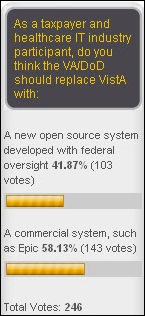






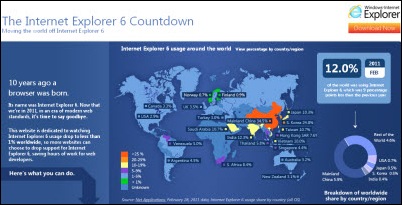
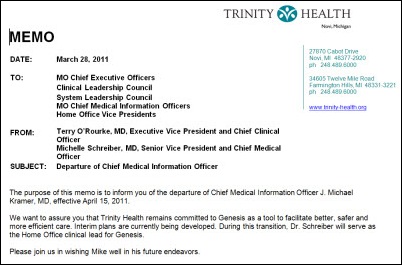

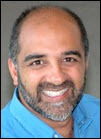









 From Quilmes Boy: “Re: Google Health. Just heard a rumor that they are not pursuing development or sales.” Unverified, but strongly suggested by the Wall Street Journal as CEO Eric Schmidt steps aside as CEO to make way for co-founder Larry Page. If they back out of Google Health, that ought to have a major effect on … well, nobody. PHRs are the consumer versions of EHRs — potentially useful technologies that, rightly or wrongly, aren’t all that attractive to their target audience in their current form.
From Quilmes Boy: “Re: Google Health. Just heard a rumor that they are not pursuing development or sales.” Unverified, but strongly suggested by the Wall Street Journal as CEO Eric Schmidt steps aside as CEO to make way for co-founder Larry Page. If they back out of Google Health, that ought to have a major effect on … well, nobody. PHRs are the consumer versions of EHRs — potentially useful technologies that, rightly or wrongly, aren’t all that attractive to their target audience in their current form. 
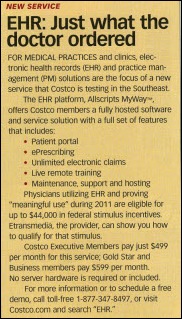

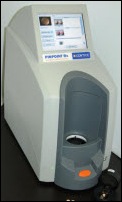
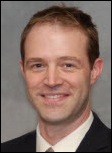


 Apple
Apple 





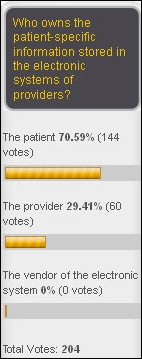






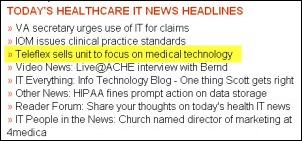


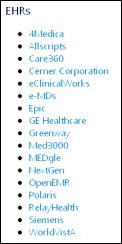

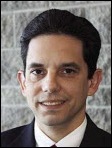




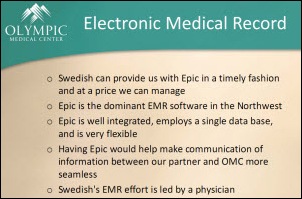


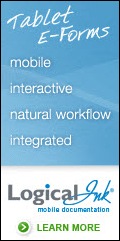

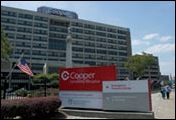





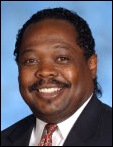














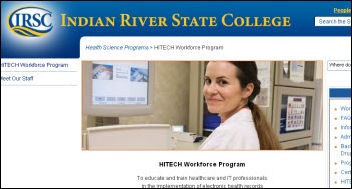

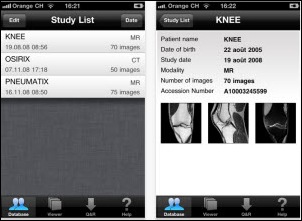

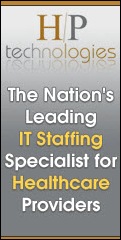



















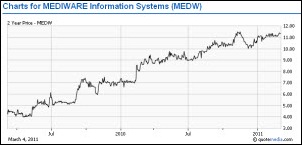





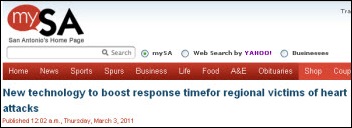



 But, on the positive side, keep shaking things up. Healthcare and healthcare IT is the most self-congratulatory industry in the world, especially considering the horrible state of affairs of both. Keep rocking the boat and calling a spade and spade. You’re good at that.
But, on the positive side, keep shaking things up. Healthcare and healthcare IT is the most self-congratulatory industry in the world, especially considering the horrible state of affairs of both. Keep rocking the boat and calling a spade and spade. You’re good at that. 


















































































Would have liked to have seen more about Expanse here. Would like to see more about it on this site…